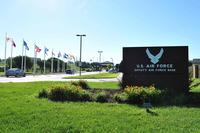Now that the V-22s have landed in Afghanistan, it's time to take a look at how they will be used. Robbin Laird, a defense consultant who works for the Marines -- among other clients -- got a chance to interview the flight crews of VMM-261, headed by Lt. Col. A. J. Bianca, about the concepts of operations they expected to follow. We've got links to the interviews, an interview with Laird and links to video of the V-22 teams undergoing deployment to Afghanistan and some of their training.
The top benefit of the V-22 in Afghanistan is a simple one, Laird said. It is not a helicopter. "Rotorcraft have been used for a long time in Afghanistan and the bad guys know how to target them," he noted. Of course, that experience for many of the older Afghans includes using Stinger missiles against the Soviet's helicopters.
The V-22 "gives the Marines a lot of advantages," Laird said. The exact operating ceiling is classified but these Ospreys are operating at more than 20,000 feet.
In one of the interviews Laird did, he quoted a Marine pilot who noted that the Osprey does have limitations when it flies at its highest altitudes. "Now obviously, we can’t carry passengers at our highest altitudes. We can certainly carry cargo. We can go to get passengers and we can carry passengers down at lower altitudes. But flying at higher altitudes makes you a whole lot faster.
"And I see that really glossed over when this airplane is briefed, you know. The average ground person, or someone who’s not a pilot, or even a rotary pilot, may not fully understand it. At higher altitudes, you’re about a hundred knots faster than you are on the surface, in any airplane, Tiltrotor or otherwise," the Marine told Laird.
Second, the Ospreys afford the Marines much greater range than do helicopters. Helos have to land much more frequently to refuel and Laird says the V-22s in Afghanistan "have been able to avoid many attacks because of their mobility."
Also, the V-22 can provide the Marines with a more effective envelopment tool. Suppose a UAV identifies a target that is not susceptible to a precision strike and a helo can't get there in time. A CH-46 or a 53 needs two FARPs to travel the distance an Osprey can cover without landing.
"I've got to bring the helo up one or two times and refuel it, and that's a lot of hours," Laird noted. "The Osprey is there in 90 minutes or, at least, much more quickly than any helo could arrive." In some cases, the FARP for a helo mission will have to be established, eating up valuable time and increasing the vulnerability of both the helos and the ground crews supporting them.
"If you think back to Vietnam, that was one of our biggest vulnerabilities -- having all these huge fuel dumps scattered around the country," Laird said.
The other benefit of the Osprey's extended range and speed, compared to a helo in terrain like Afghanistan's, is that a smaller number of Ospreys "can support several combat groups at once."









